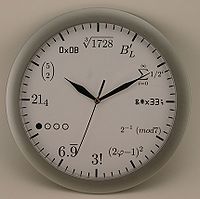Course:MATH103/Archive/2010-2011/207/Lectures/Lecture25
| Faculty of Science Department of Mathematics | |
|---|---|

| |
| Course Pages | |
| Course Policies | |
| Math Solvers | |
| Exams | |
| Quizzes | |
| Assignments | |
| Lectures | |
Lecture 25
Readings For This Lecture
None
Summary
Group 6: This is a review class. Feel free to create examples and discussions on any topic in the course.
1. The Taylor Series for the function (1/(1+x^2)) around x=0 is 1-(x^2)+(x^4)-(x^6)+(x^8)
Use this fact to find the Taylor Series for arctan(x) around x=0
simply antidifferentiate the above series to make the taylor series for arctan(x)=
x-(x^3/3)+(x^5/5)-(x^7/7)...
2. Write down the first five terms in a Taylor Series for f(x)=e^x
e^x=1+x+(x^2/2)+(x^3/3)+(x^4/4)
3. Find the integral: integral(tan(x)sec^2(x)*dx
Let u=tan(x) du=sec^2(x)*dx (u^2)/2 +C sub back orginal function
tan^2(x)/2 +C
4. Evaluate the integral int(x*ln(x))*dx
let u=lnx du=1/x dv=x and v=(1/2)x^2
=ln(x)*(1/2)x^2-integral(1/2)x^2*(1/x)*dx
=(1/2)x^2lnx-(1/2)(x^2)/2
=(x^2)/2(ln(x)-(1/2)
5. Evaluate the definite integral integral from 0 to 1 of e^x/(e^2x +1)
let u=e^x du =e^x*dx
integral from 0 to 1 of du/(u^2 +1)
=arctan u evaluated at 1 and e
=arctan(e) -arctan (1)
=arctan(e)-pi/4
6. Find f(x) if x^2=1+int of 1 to x f(t)dt
d/dx(x^2)=d/dx(1+int of 1 to x f(t)dt)
2x=0+f(x)
therefore f(x)=2x
7. Determine if the integral from e to infinity of dx/(x(lnx)^3 converges or diverges. If it converges what is the value?
lim as R-infinity of integral of e to R dx/(x(lnx)^3 let u=lnx
lim as R--infinity [-1/2(lnx)^2]evaluated at e and R converges to (1/2)
8. Determine the value of the Reiman Sum of sigma k=10 N=50 of (k-2)
=(1+2+3+4...48)-(1+2+3..7)
=(48)(49)/2-(7)(8)/2
9. Find the Volume of y=(x)^(1/2) revolved around the y-axis.
V=pi*integral from 0 to 1 of (y^2)^2*dy
=pi*y^5/5 evaluated at 0 and 1 =pi/5
10. Determine an integral for the arc length of x-(2/3)(y-1)^(3/2) for the interval [2,5]
L=interal from 2 to 5 of the sqrt(1+f`(x)^2)dy L= int from 2 to 5 sqrt(y)*dy
11. The average value of f(x)=x^2 on the interval [b,1] is 1/3. What is b?
f=(1/(1-b)) int from b to 1 of x^2 dx
=(1/(1-b))*[1/3*x^3] evaluated at b and 1
=(1/(1-b))[(1/3)*(1^3-b^3)] foil this out and you get
(1/3)*(1+b+b^2)=1/3
b=0 or b=-1
12. Consider the equation f(x)=3+ integral of 0 to x (f(t)-)(f(t)-2)dt What is f(0)?
3+ int from 0 to 0
=3
13. Find the differential equation satisfied by f(x)
f`(x)=3+int from 0 to x(f(t)-1)(f(t)-2)dt]
=0+f(x)-1)(f(x)-2)
dy/dx=(y-1)(y-2) y(0)=3
14. Find all steady states of the differential equation dy/dt=y^3-y that are stable.
dy/dt=0 therefore y^3-y=0 y=0,1,-1.
By drawing a vector field, we see that y=0 is the only stable steady state.
What is the half life of a given radioactive substance pdf =P(t)=Ce^-kt
Find the MEDIAN! therefore
F(t)= integral from 0 to t of Ke^-ks ds
=-e^-ks evaluated at 0 and t = 1-e^-kt=(1/2)
(1/2)=e^-kt
2=e^kt
ln(2)=kt t=ln(2)/k